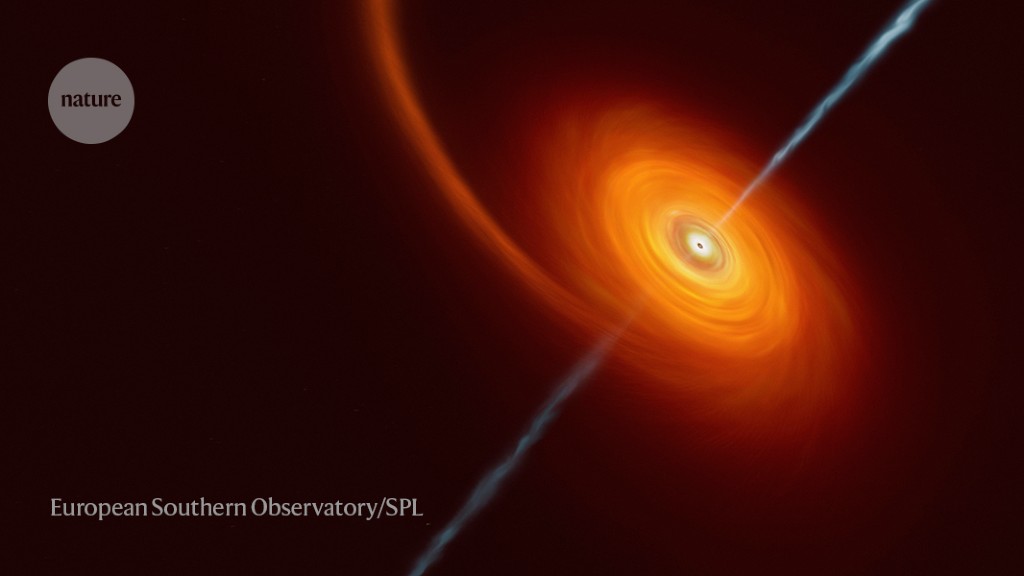‘It’s a dream’: JWST spies more black holes than astronomers predicted

The James Webb Space Telescope’s observations could help to answer questions about how the celestial objects formed early in the Universe

Black holes (as shown by this artist’s impression) draw in gas and dust that whirls around them like water going down a drain.Credit: European Southern Observatory/Science Photo Library
Last August, astrophysicist Dale Kocevski posted a paper to the arXiv preprint server with some preliminary data on what the new James Webb Space Telescope (JWST) was discovering about black holes in one of its surveys of the Universe. The article, now formally reviewed and published1, did not predict that JWST would bring revolutionary insight into the enigmatic celestial objects. “And that was proven completely wrong,” says Kocevski, who is based at Colby College in Waterville, Maine.
Weeks after that posting, the floodgates opened. One preprint appeared last September2, followed by a cascade of others in recent months3,4,5,6,7,8,9,10,11, announcing the existence of more black holes in the distant Universe than astronomers had dreamed of seeing. Just today another dozen newfound black holes were reported in a preprint12. JWST’s unprecedented power has allowed it to discover a huge range of these objects — from many faint, distant black holes to a handful of bright ones raging even farther away.
“It’s truly studying parts of the Universe that just weren’t available to us technologically,” says Rebecca Larson, an astrophysicist at the Rochester Institute of Technology in New York.
JWST’s black-hole studies are still in their early days, and astronomers caution that much remains to be resolved. But it’s already clear that its discoveries could help scientists to answer many long-standing queries about black holes, such as how they managed to form early in the history of the Universe and grow quickly into cosmic vacuums, sucking up everything around them.
Seeds of growth
Black holes come in several sizes, but the ones JWST has been detecting are massive ones that weigh millions to billions times as much as the Sun. Astronomers aren’t sure how these black holes form, but it might involve massive stars or gas clouds collapsing and then beginning to draw in nearby gas and dust. In this scenario, these black-hole ‘seeds’ would grow rapidly, until they become gravitational maws that lurk at the heart of most galaxies.
Black holes are not themselves visible — their immense gravitational pull means that not even light can escape from them — but they can be spotted by searching for the superheated gas that spirals around them like water going down a drain. Before JWST, astronomers studied black holes using a range of space- and ground-based telescopes. But these could spot only the brightest black holes, including those that are relatively close to Earth. JWST is designed to see light coming from the distant Universe and can see black holes lying farther away — including ones that astronomers thought would be too dim to detect.
Distance in the Universe can be measured by a quantity known as redshift; the higher an object’s redshift, the more distant it is and the earlier it appears in the Universe’s history. Many of JWST’s newfound black holes lie at redshifts of between 4 and 6, which corresponds to a time when the Universe was about 1 billion to 1.5 billion years old.
In JWST images, these faint black holes appear as small and fairly unimpressive blobs, but “they are clearly different” from the galaxies surrounding them, says Jorryt Matthee, an astrophysicist at the Swiss Federal Institute of Technology in Zurich.
So far, JWST has discovered roughly ten times as many faint black holes at these intermediate redshifts than would be expected on the basis of the number of black holes previously known. Why that is “we don’t understand yet”, says Kohei Inayoshi, an astrophysicist at Peking University in Beijing.
Lurking in the distance
JWST has also found several of the most distant black holes ever seen. The confirmed record holder of the bunch8 sits at the heart of a well-studied galaxy, called GN-z11, which has a redshift of 10.6. This suggests that as early as 400 million years after the Big Bang, the seeds for black holes had already formed and were able to create a supermassive object. Upcoming observations aim to probe the details of how superheated gas flows around GN-z11, which could shed light on how the black hole is affecting the space around it, says Hannah Übler, an astrophysicist at the University of Cambridge.
To JWST, distant black holes look like blobs — detected because of the gas and other matter whirling around them. The black hole at the centre of the CEERS 1019 galaxy lies more than 13 billion light-years from Earth.Credit: NASA, ESA, CSA, Leah Hustak (STScI)
JWST also spotted a probable black hole at a redshift of 8.7, in the galaxy CEERS 1019. The black hole somehow managed to accumulate 9 million times the mass of the Sun in the first 570 million years of the Universe6. And there is even a candidate black hole at redshift of 1211.
Such distant JWST discoveries fit with recent simulations of the birth of early black holes13, says Raffaella Schneider, an astrophysicist at the Sapienza University of Rome. She and her colleagues have found that big black holes can form in the early Universe if they gobble gas at incredibly high rates in their early stages14. This would violate the maximum rate at which black holes can grow, according to theory. But JWST observations suggest that some black holes, such as the one in GN-z11, might grow this way — and that the theory might need revising.
For Priyamvada Natarajan, an astrophysicist at Yale University in New Haven, Connecticut, the fun is just getting started for JWST black-hole discoveries. “This is very early, quick stuff, with a lot more to come,” she says. “It’s a dream. Honestly.”
doi: https://doi.org/10.1038/d41586-023-02460-5
This story originally appeared on: Nature - Author:Alexandra Witze


















